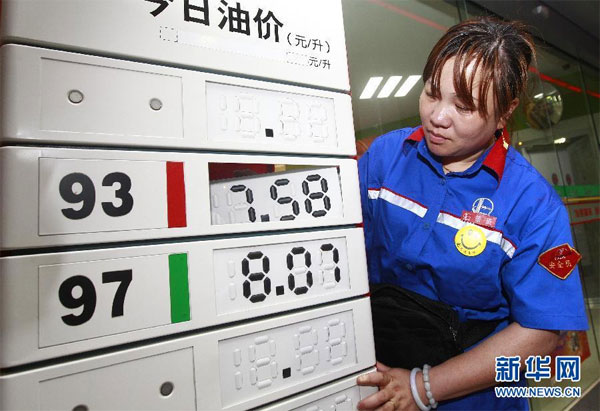Fuel prices cut to fight slowdown
 0 Comment(s)
0 Comment(s) Print
Print E-mail China.org.cn, June 9, 2012
E-mail China.org.cn, June 9, 2012
Gasoline and diesel prices have been cut for the second time in a month amid growing government efforts to reverse a sharp slowdown in the economy.
 |
|
A staff changes the price tags at a gas station in Shanghai early Satruday morning. [Xinhua] |
The reduction of 530 yuan (US$83) per ton for gasoline and 510 yuan per ton for diesel, or nearly 6 percent, is the largest since late 2008 when the current pricing system was introduced by the National Development and Reform Commission (NDRC).
Effective on Saturday, the ceiling retail price for 93-octane gasoline is 7.58 yuan per liter, or US$4.50 per gallon, down from 8.01 yuan; 97-octane gasoline falls to 8.07 yuan from 8.52 yuan; and zero-grade diesel is now 7.48 yuan down from 7.92 yuan.
The reduction came after an interest rate cut on Thursday — the country's first in nearly four years — prompting analysts to suggest that data due this weekend will show May trade and industrial activity was even weaker than pessimistic forecasts had suggested.
"Markets are bracing for a potentially bad set of May economic data for China," said Moody's Analytics economist Alaistair Chan in a report.
China had raised fuel prices in February and March.
The moving average price of Brent, Dubai and Cinta, a basket of oil prices that China refers to for fuel price adjustments, has dropped by more than 9 percent so far since the last reduction.
The move is the second cut this year, indicating the country's determination to have domestic fuel prices more closely linked to global oil prices, even though the latest cuts were narrower than market expectations by at least 600 yuan a ton.
"I think this time they acted quickly but not enough, I hope we never get back to the '8 era' again," said a Shanghai driver Liu Ke, referring to a term coined by Chinese media earlier this year when fuel prices first appreciated beyond 8 yuan per liter.
The NDRC has long been criticized by the public for not acting swiftly when crude prices fall but moving very fast when they rise. The commission has said in the past that it actually had delayed or cut the size of price increases due to inflation concerns.
The cut may help lower transport and storage costs for operators in key industry sectors such as agriculture, forestry and fisheries, said Han Jingyuan, an analyst with JYD Commodities Hub, a petrochemical e-trade platform.
However, the lower fuel prices will hurt the refining business of Sinopec Corp and PetroChina Co. Liu Li-Gang , chief China economist with Australia and New Zealand Banking Group said China's proposed crude oil futures, which the Shanghai Futures Exchange plans to launch within the year, will give oil producers a new channel to hedge their oil positions and the spread between crude and refined products, and will reduce their foreign exchange risk if the contracts are settled in yuan.
Both Brent crude oil prices and crude futures at the New York Mercantile Exchange registered their biggest drops since 2008 in May, dampened by the bleak global economies, in particular the deteriorating debt crises in Europe.
The oil price plunge, however, raised hopes that China may start its fuel pricing reforms.
Under the current mechanism, started in 2008, the government may adjust fuel prices if the average movement of the three reference markets' oil prices change 4 percent.
The current pricing program remains complex and not nimble enough to reflect global crude oil prices, said Zhou Dadi, former director of the NDRC's energy research institute, adding that further reform to reflect supply and demand is a must.
The government may take the opportunity of global price drops to narrow the gap between international and domestic crude charges, and then introduce reforms to avoid volatility and market speculation, JYD's Han said.
The revamp of the current pricing program is now just a matter of time, said Han Wenke, director of the NDRC's energy research institute.
(China Daily, Shanghai Daily contributed to the story.)






Go to Forum >>0 Comment(s)